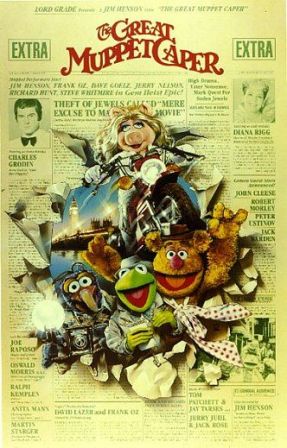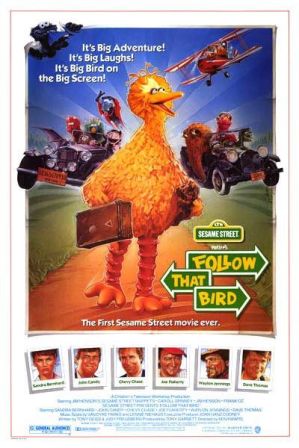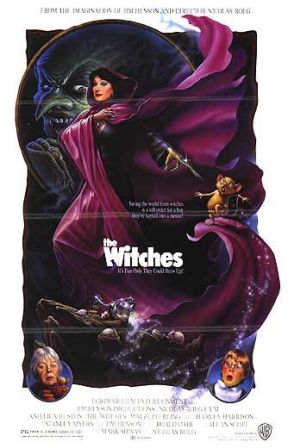CHICAGO – In anticipation of the scariest week of the year, HollywoodChicago.com launches its 2024 Movie Gifts series, which will suggest DVDs and collections for holiday giving.
Film Feature: The 10 Best Muppet Movies Ever Made
7. “The Great Muppet Caper” (1981)

The Great Muppet Caper
Photo credit: Disney
As an elegantly-staged novelty, this ode to ’30s-era Hollywood is a hoot. In his feature directorial debut, Henson is as subversively self-reflexive as ever, allowing the Muppets to consistently break the fourth wall, poking fun as the formulaic plot that they’ve found themselves trapped within. After one character is asked her reason for rattling off a laundry list of story detail, she replies, “It’s plot exposition, it has to go somewhere.” Henson makes no secret of the fact that his caper yarn is merely a clothesline on which to hang a series of spectacular set-pieces featuring remarkably advanced animatronic effects. After Kermit famously rode his Schwinn bicycle in his film debut, this second screen outing allows the Muppets to ride bikes together in a group. They also scale walls, tap dance, crawl on the floor, and in one particularly memorable shot, crash a motorcycle through a stained glass window. Joe Raposo’s songs are funny and splashy but ultimately lack the heart of other Muppet musicals. Yet his melodies still manage to drive the film’s two best sequences, each providing a larger-than-life stage for Piggy to shine like never before. The most memorable tune by far is “The First Time It Happens,” a Henry Mancini-style ballad that morphs into a rousing Busby Berkeley-like dance sequence. There’s also a hilarious Esther Williams-inspired swimming routine where water is seen bubbling out of Piggy’s nostrils. The passel of cameos seem sloppily tacked on, save for John Cleese’s dryly amusing portrayal of a boorish husband and Charles Grodin’s deadpan brilliance as a laughable sleaze infatuated with Piggy. One could easily imagine Grodin and Piggy starring in a spin-off of “The Heartbreak Kid [Pig].”
6. “Follow That Bird” (1985)

Follow That Bird
Photo credit: Disney
Few Muppeteers were as accomplished as Caroll Spinney, the versatile genius who played Big Bird and Oscar the Grouch for a full four decades on “Sesame Street.” Though Spinney starred in several TV specials as well, “Sesame” fans tend to forget this big-screen vehicle, which now plays like a nostalgic portal into the past glories of what used to be the single greatest family program on television. Picture a time back when Elmo was a mere extra, Cookie Monster wasn’t a health nut and Ernie and Bert were accepted as the chaste, heterosexual friends that the are. That’s the “Street” I remember from my childhood, and it’s wonderfully preserved by Ken Kwapis’ delightful road comedy. Though Big Bird is technically the star, he’s routinely upstaged by Oscar, who brings down the house with his uproarious Grouch anthem, which he delivers in front of a giant, “Patton”-sized flag.
Judy Freudberg and Tony Geiss’ script has a thorough understanding of Big Bird’s timeless appeal to kids: he’s a kid himself, who just so happens to be inhabiting a gawky body that towers over adults. In this film’s opening scenes, Big Bird is adopted by an avian family closer to “his own kind,” thus leaving Sesame Street at the forceful invitation of the vindictive Ms. Finch (Sally Kellerman). Yet Big Bird quickly regrets the move and flees back home, which sets off a zany cross country road trip, as his friends drive to the rescue. Too much screen time is spent on the bumbling crooks intent on turning Big Bird into a carnival freak, but their subplot does lead to Randy Sharp and Karen Brooks’ timeless tearjerking tune, “I’m So Blue.” In fact, all the songs in the film are first-rate, especially those written by Jeff Moss: “One Little Star” (beautifully performed by Alaina Reed-Hall) and “Upside Down World” (sung by Ernie and Bert, who are truly one of the all-time great comic duos). And let’s not overlook the priceless sequence set in a Grouch restaurant (featuring Sandra Bernhard as a scowling waitress) that brings new meaning to the term “toss salad.”
5. “The Witches” (1990)

The Witches
Photo credit: Disney
Released three months after Henson’s death on May 16, 1990 at the age of 53, this triumphantly spooky fantasy hints at what the late genius could’ve been capable of later in his career. His ingenuity and audacity are still present in this picture (for which he served as executive producer), but they are perfectly married with the vision of director Nicolas Roeg (“Walkabout”) and the spirit of author Roald Dahl, whose marvelous book served as its source material. Anjelica Huston elevates scenery-chewing camp to the level of an art form as the monstrously rodent-like Grand High Witch, whose ghastly features are squeezed beneath a coldly radiant face. The comedic and horrific high point of the picture takes place in a banal boardroom where the witches gather for their annual conference and Huston undergoes her hideous transformation, while unveiling her potion designed to turn children into mice. This is where Henson’s painstaking craftsmanship comes into play. His Creature Shop’s designs for the mice are superb combinations of puppetry and animatronics that somehow manage to convey the personalities of the children while still looking authentic alongside actual animals. One of the witch’s first victims is Luke (Jasen Fisher), a Harry Potter-like chap whose grandma (Mia Zetterling) had a previous run-in with Huston. Generations have loved the film because it pits the small, cunning mice (whose perspectives are conveyed through multiple floor-level shots) against the grotesque adults. Roeg’s background in horror (“Don’t Look Now”) makes him well-equipped for this material, and he creates some genuinely chilling moments, such as when a child becomes imprisoned within a painting. Zetterling’s moving and wryly funny performance single-handedly carries her scenes with Fisher, who appears as detached as a young Daniel Radcliffe.
4. “The Muppets Take Manhattan” (1984)

The Muppets Take Manhattan
Photo credit: Disney
Since they were made during the last eleven years of his life, each of Henson’s big screen endeavors are marked by a sense of loss, yet none more so than his final theatrical vehicle for Kermit and the gang. This is easily one of the funniest and most touching of all Muppet movies, enhanced by the infectious rhythms of Jeff Moss’ songs, which gained great poignance in the aftermath of Henson’s death (the Muppeteers performed Moss’ “Saying Goodbye” at Henson’s funeral). In the director’s chair, Oz builds the comedic setpieces beautifully while allowing for moments of real warmth. Whereas the Muppets instantly gained Rich and Famous Contracts from Hollywood producers in “The Muppet Movie,” here they’re forced work from the ground up in order to become stars on Broadway. Without Henson’s customary winks to the audience, Oz creates a stronger narrative for the Muppets to inhabit, while giving Kermit more depth and range than ever before. He snaps on his perpetually needy friends (“Can’t you take care of yourselves?”) and tries on a variety of disguises in order to break into show business, occasionally acquiring the desperation of Rupert Pupkin.
Oz and co-writers Tom Patchett and Jay Tarses also dream up some truly funny sketches for the celebrity cameos, the best of which belong to Joan Rivers (who cheers up Piggy with a ghoulish makeup job) and Gregory Hines (who earns big laughs with the line, “You gave Jenny the huggies?”). As college graduates attempting to get their variety show, “Manhattan Melodies” seen on Broadway, the Muppets go through the relatable growing pains of budding artists attempting to realize their dreams. Henson personally staged a marvelous “rat scat” sung by Rizzo the Rat (Whitmire) that proves to be just as catchy as Moss’ “I’m Gonna Always Love You,” performed during a charming “flashback” sequence that launched the “Muppet Babies” series (which debuted later that year). It’s nearly impossible to avoid getting misty-eyed during Henson’s final line, “What better way could anything end—hand in hand with a friend?” since it ultimately proved to be the end in more ways than one.


